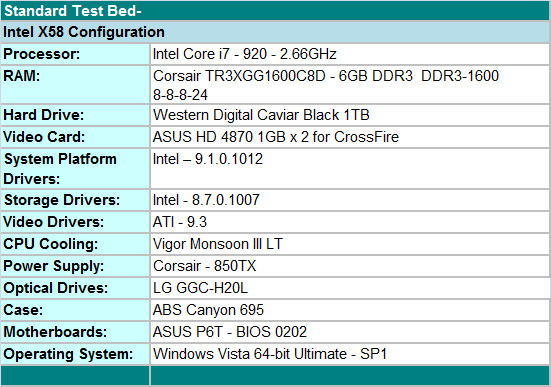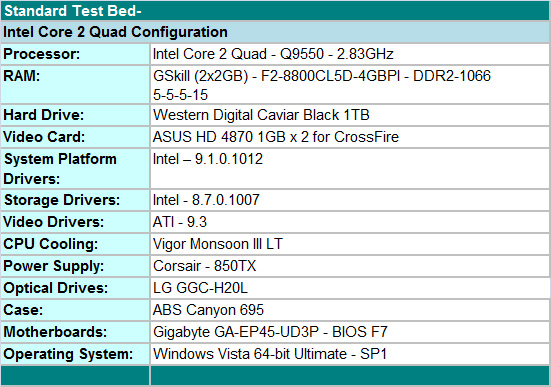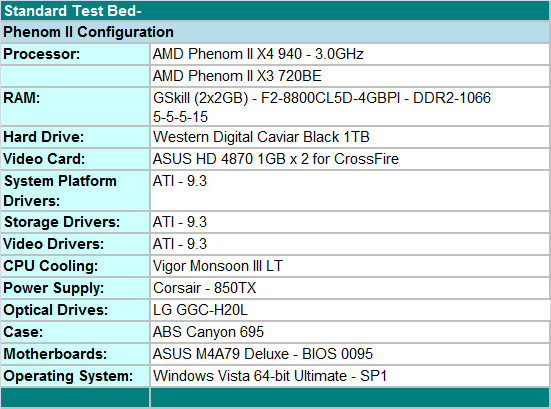Phenom II X3 720BE & CrossFire X Performance - Does it Compete?
by Gary Key on March 28, 2009 12:00 AM EST- Posted in
- Motherboards
Test Setup
Fortunately for us, during motherboard testing we test SLI or CrossFireX solutions extensively. However, we do not test the graphics cards in the same manner as we do in a GPU review. During motherboard testing, we focus on ensuring compatibility, identifying any layout problems, and checking performance deltas between motherboard chipsets. Instead of running absolute GPU intensive settings, we seek a balance of playable settings that ensures decent platform performance. This means reasonable resolutions and 2xAA/8xAF settings to keep the GPU from being a limiting factor where possible. We think these quality settings are fine for most users, especially in FPS games where the differences between 2xAA, 4xAA, or 8xAA are usually minimized due to the speed of the game.
We run our benchmarks at two of the most popular resolutions for new systems, which happen to be 1680x1050 and 1920x1200, although 1920x1080 is gaining traction quickly. We mention this now as our overview of CrossFireX performance will not have 2560x1600 at 4xAA/16xAF results or tri-card setups. The population of 30” monitors is rather small and except for Crysis, tri-card performance is usually worse or at best a break even experience compared to dual card performance with our mid-range setups. Consider this review a snapshot of CrossFireX performance with one particular GPU selection as we will not be looking at other ATI cards except the HD4870 1GB.
Our test systems today are based on similar components where possible. The Intel Core 2 Quad and AMD Phenom II platforms will satisfy the requirements of most enthusiasts looking for great performance from mid-range setups. We selected a “mid-range” Core i7 setup that is capable of both SLI and CrossFire to ensure platform consistency in future articles.



Our decision to go with a 790FX/SB750 combination on the AMD side is strictly based upon performance. The 790FX is about 3%~5% faster on average than comparable 790GX products in multi-GPU configurations. AMD continues to recommend the 790GX/SB750 as the platform of choice for the AM2+ and upcoming AM3 products. We disagree from a performance viewpoint; the 790FX/SB750 combination is simply the best choice in our opinion. Of course you will typically pay about $35~$40 or greater for the 790FX boards, but if you intend on running CrossFireX or benchmarking, we think it is worth the additional cost. We changed motherboards from our original DFI selection to the ASUS M4A79 Deluxe as we will be utilizing the M4A79T Deluxe in an upcoming DDR2/DDR3 memory comparison article.
On the Intel side, we decided to go with the P45 chipset as it offers a very balanced blend of performance and value. The Gigabyte GA-EP45-UD3P is a superb CrossFire capable motherboard that also happens to be one of the best overclocking S775 products around. The P45 offers dual PCI Express x8 operation in CrossFire mode compared to dual x16 on the 790FX, X48, and X58 boards. However, we did not notice any performance differences between dual x8 and dual x16 operation when comparing the P45 to the X48 in offline testing utilizing our resolutions and quality settings.
The i7 setup can be cost reduced easily without sacrificing any "real and perceivable" performance due to a motherboard and memory alternatives currently available in this market sector. If you are only interested in CrossFire capability on the X58, motherboard costs are now in the sub $200 range. The price of DDR3 has dropped dramatically this last month with very good DDR3-1333 6GB memory kits going for $90 or so now.
We selected the ASUS EAH4870 DK/HTDI/1GD5 video card. It is a non-reference design that offers improved thermals and acoustics over the standard HD4870 1GB cards on our board choices. We think if a user is going to run CrossFireX on one of these platforms, then the best possible performance choice is the HD4870 1GB, at least until the HD 4890 ships next week. Depending upon pricing on the HD 4870 1GB cards or upcoming HD 4890 cards, a 4870X2 might be a better choice for users wanting CrossFireX.
The WD Caviar Black 1TB is our hard drive of choice for storage purposes. LG’s Blu-ray playback capable drive fills in for optical duties. We purchased two of G.Skill's impressive DDR2-1100 4GB kits that operate at speeds up to DDR2-1240 on our boards with about 2.1V of VDimm. We used 4GB in our Phenom II and Core 2 Quad systems with memory set at DDR2-1066 with 5-5-5-15 timings at 1.8V. Our DDR3-1600 6GB kit is from Corsair and was dialed in at DDR3-1600 with 8-8-8-24 1T timings at 1.60V. Vigor provided their Monsoon III LT CPU cooler that offers mounting kits for the 1366, 775, and AM2+/AM3 processors. ABS provided their Canyon 695 case and it has proved to be exemplary during testing.
Our game selections are a few of the recent top selling titles. Certain titles that are capped at 30FPS like Command and Conquer Red Alert 3 or do not benefit from CrossFireX (Flight Simulator X) were not included. We tested Grand Theft Auto IV with the latest 1.03 patch but those results are not available today.
We are also including results with our processors overclocked for CrossFire only. Overclock results with a single card configuration provided little benefit in most cases. Simply overclocking the video cards resulted in better performance numbers than overclocking the processors with this configuration. We switched from the 8.12 driver set to the 9.3 for this article. The overall numbers are extremely close between the two driver sets. The only measurable differences we noticed occurred in Crysis Warhead where the Intel platforms performed better at 1920x1200 and in CrossFire performance.
The Phenom II 940 in our previous article was overclocked to 3.95GHz (17.5x226, DDR2-1205, 5-5-5-18, NB Speed 2486Mhz), however, we discovered in later testing that performance just was not where it should have been at that CPU speed. Part of the problem was thermal related as we were bumping right up against the limits of the CPU and board on air cooling. Also our BIOS was not fully optimized for the Phenom II 940 and we continue to experience instability and performance degradation near 4GHz with Vista 64. A problem that we are still working on with AMD.
As such, we set our Phenom II X4 940 overclock to 3.8GHz (19x200, DDR2-1066 5-5-5-15, optimal sub-timings) and realized that the performance delta was minimal compared to previous results. In fact, it was so minimal that our original conclusions have not changed at all. We also clocked our Phenom II X3 720BE to the same 3.8GHz core speed with like memory settings. The only difference between the settings (includes optimal memory sub-timings) is that the Northbridge speed on the 940 defaults to 1.8GHz compared to 2GHz on the 720BE. We will look at the effects of Northbridge speeds in a separate article shortly, but our recommendation is to run it at 2.6GHz+ ASAP.
The Core 2 Quad Q9550 is set at 4.25GHz (8.5x500, DDR2-1000, 5-4-4-12), and the Core i7 920 at 4GHz (20x200, DDR3-1600, 8-8-8-24). These were the maximum stable overclocks on air-cooling that we could sustain in a 24/7 setup with Vista Ultimate 64 SP1. Our particular 940 processor will hit 4.2GHz under Vista 32 and the 720BE tops out around 4.15GHz before requiring additional cooling. We just want to reiterate one more time that we are not crippling the AMD systems on purpose. There is a definite clocking problem with the Phenom II series under Vista 64 without resorting to exotic cooling methods. Our standard test beds have all moved to Vista 64 Ultimate SP1 and will soon move to Windows 7 64 along with a very 64-bit centric application test suite. As such, it is what it is until AMD can provide a solution to this problem.










59 Comments
View All Comments
Hrel - Saturday, March 28, 2009 - link
Great Article, good stuff to know. However, in the future, when you're doing a CPU article I'd appreciate it if you'd include results for the E8400 Core 2 Duo; as that was the processor to get for some time. I'm sure I'm not the only one that put that CPU in just about every computer built for some time. It'd be nice to see how it stacks up to the newer CPU's.On another note; it'd be nice if you could include performance results for the 8800GT/9800GT in future GPU articles; as that WAS the GPU to get for so long. I'm sure there are tons of people out there that still have that GPU running in their systems. No matter what the point of the article is or what level of intensity you're putting the cards through; it's always nice to have something to go off of to compare what you have now; to what's just coming out.
7Enigma - Tuesday, March 31, 2009 - link
My gaming computer I built back in January uses the E8500 as at the time it was for me the best bang for the buck. I have it OC'd to 3.85GHz on stock voltage, with tremendous headroom if I ever decide to up the voltage (Xigmatek 120mm rifle cpu cooler). If I was building today I would probably go with the AMD X3, but for my gaming (currently on 19" LCD with plans to go to 24" probably in the next 2 years), the E8500 has more than enough grunt.atlmann10 - Saturday, March 28, 2009 - link
The percentage of people who actually use a computer to it's abilities today is so minimal its almost self defeating. This percentage on this boards and most hardware discussion boards would be a good bit different. But, when you average that to the computer users in the US that is unremarkable at any percentage level. Do not get mad at me; because, I am not talking at least specifically, on the large part of people on here. Software development much less released product is so far behind the hardware market it is also unremarkable. Yes maybe somewhere between 3-10% of high end newly releases games put a computer to a decent percentage of usage but that percentage is unremarkable at best. Next month AMD releases the rest of the Phenom 2's and in September INTEL releases it's newest processors to make this even more so. I think when I upgrade (probably the middle of this summer (Julyish), I will most likely go for the 920. But the arguments especially some of the more ridiculous in this exact forum are childish, and I imagine that super harsh comment was posted by a 13 year old. At least I would hope so, if not you (that commenter specifically) need to truly evaluate you mental sense of operation. For childish comments like that you need to go to the Nickelodeon website, if they have a discussion of this type of equipment. Anyway; the main point of my post is this, Software developers need to get off there A77, and make some products that use the hardware to at least a 50% level more than 5% of the time.Beno - Saturday, March 28, 2009 - link
this just shows that those games arent written for quad core processors.Summer - Saturday, March 28, 2009 - link
The article did a good job concluding that one can build a good gaming machine without spending too much. Emphasizing on real game performance is a plus especially to the average consumer who just wants a decent system to play today's popular games. Hopefully the average anandtech reader won't think too much about the article and turn it into another AMD versus INTEL e-penis thread.SIDENOTE: I'll definitely be looking forward to the Northbridge article.
nubie - Saturday, March 28, 2009 - link
What about performance of the x2 7750 that you can buy on ebay for $49 (free shipping) and Newegg for ~$65 (+tax and shipping)?I haven't even seen a review of this processor that I can remember, is it Phenom I or II? Is it built from a quad-core die like the x3?
They seem to overclock well, would they do for a real budget gaming system, say ~$300-400 for the entire system including a HD4xxx or 9800 series card?
I appreciate your "mainstream" bias, but some people have no money and just want to run the games or keep their system usable without laying out more than $100 for an upgrade.
Roland00 - Saturday, March 28, 2009 - link
The x2 7750 is a Phenom 1 chip with two cores disabled. I haven't seen reviews here but there have been several reviews at other sites. It is comparable at stock to an e5200 from intel (the x2 7750 is barely faster, but not by much.)Once you start OC either chip the e5200 is a better chip for it has far more OC headroom. In addition the e5200 is comparable in price to the x2 7750.
Eventually we are going to get Phenom II dual cores but that is going to be several months from now.
nubie - Saturday, March 28, 2009 - link
Yeah, I found an e5200 for $59 on ebay, as soon as I can get my P6N RMA'd by MSI to support 45nm processors I am going to try for 4Ghz (my Scythe Infinity should be up to the task ;) )If AMD and DFI hadn't dropped support for my Infinity-AM2 I might have stayed with AMD.
Thanks for the info on the Phenom 'x2'. I wonder when we will get a Phenom II tech processor for under $100 (preferably closer to $50).
iamezza - Tuesday, March 31, 2009 - link
The x2 7750 actually does really well in gaming benchmarks compared to the e5200, but gives up a bit in application performance.It uses a lot more power than the intel chips though and has less overclocking headroom.
It does have a potentially better upgrade path with the AM2+ socket being able to accept future AM3 CPUs from AMD whereas the intel socket 775 won't be getting any new CPUs for it.
buzznut - Saturday, March 28, 2009 - link
So I didn't see too many comments that were actually about the article, go figure.I think its awesome that someone is writing articles that are for "the rest of us", people who cannot afford the latest and greatest and have to make compromises to build themselves a new system. Or don't receive products to test and so are able to build the most ridiculous, benchmark busting, $4000, top of the top end behemoth.
If I had seen this article a month ago, I might not have bought the PII X4 940 and yet I am still glad I did. I do alot more than just gaming on my pc.
I would find it even more interesting to take the intel processors and clock them to 3.8ghz (or same speed as the AMD proc.) and run the same battery of tests; yes I know that is not the point of this article.
And I see why you would want to see the max performance available from each chip.
About a year ago or even as recent as 6 months ago, everyone was saying what a stupid move it was for AMD to acquire ATI and basically counting AMD out as far as competing ever again. Right now, AMD doesn't look too stupid to me. Seems to me they are doing quite well with developing the "platform" as their strategy for getting their share of the market.
Look at the way Nvidia and Intel are fighting right now. I think AMD has the right idea and are moving in a sound direction. I think they have compelling products, certainly from a budget pc users standpoint. I know others will not agree, judging from AMD's bottom line in the recent past and even currently, but they appear to be moving in a positive direction.
I think AMD's graphics division is firing on all cylinders now.And as "bad" as the original Phenom was, the have become competitive again with Phenom 2. I am pretty impressed with the turn around.